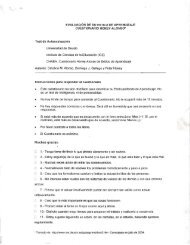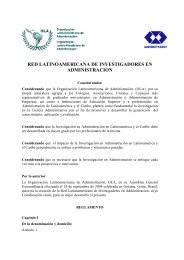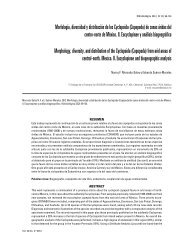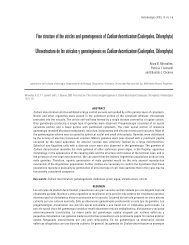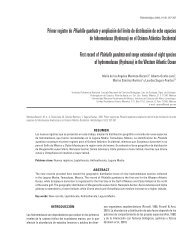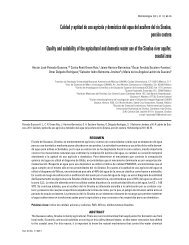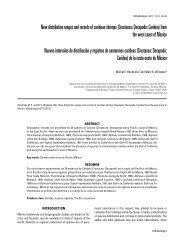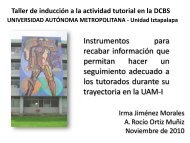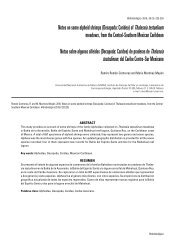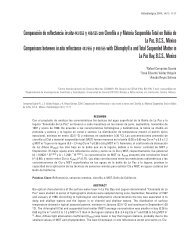Coherent states for the time dependent harmonic oscillator: the step ...
Coherent states for the time dependent harmonic oscillator: the step ...
Coherent states for the time dependent harmonic oscillator: the step ...
You also want an ePaper? Increase the reach of your titles
YUMPU automatically turns print PDFs into web optimized ePapers that Google loves.
2 H. Moya-Cessa, M. Fernández Guasti / Physics Letters A 311 (2003) 1–5<br />
We can define annihilation and creation operators as<br />
ˆb = 1 √<br />
2<br />
( ˆq + i ˆp),<br />
ˆb † = 1 √<br />
2<br />
( ˆq − i ˆp),<br />
(2)<br />
such that we can rewrite <strong>the</strong> Hamiltonian as (we set<br />
¯h = 1)<br />
(<br />
Ĥ = ˆb † ˆb + 1 ) (<br />
= ˆn + 1 )<br />
.<br />
(3)<br />
2 2<br />
Eigen<strong>states</strong> <strong>for</strong> <strong>the</strong> Hamiltonian (3) are called Fock or<br />
number <strong>states</strong>:<br />
(<br />
Ĥ |n〉= n + 1 2<br />
)<br />
|n〉.<br />
(4)<br />
Fock <strong>states</strong> are orthonormal and <strong>for</strong>m a complete basis,<br />
such that any o<strong>the</strong>r state of <strong>the</strong> <strong>harmonic</strong> <strong>oscillator</strong><br />
may be written in terms of <strong>the</strong>m. In particular coherent<br />
<strong>states</strong> may be written as<br />
|α〉=e − |α|2<br />
2<br />
∞∑<br />
n=0<br />
α n<br />
√<br />
n!<br />
|n〉=̂D(α)|0〉,<br />
(5)<br />
where<br />
̂D(α) = e α ˆb † −α ∗ ˆb .<br />
(6)<br />
<strong>Coherent</strong> <strong>states</strong> are eigen<strong>states</strong> of <strong>the</strong> annihilation<br />
operator<br />
ˆb|α〉=α|α〉,<br />
(7)<br />
and have <strong>the</strong> property that <strong>the</strong> motion of <strong>the</strong> center of<br />
mass of <strong>the</strong> wave packet obeys <strong>the</strong> laws of classical<br />
mechanics (see, <strong>for</strong> instance [8])<br />
〈α|ˆq|α〉=q c , 〈α| ˆp|α〉=p c ,<br />
〈α|Ĥ |α〉=H c ,<br />
where <strong>the</strong> index c labels <strong>the</strong> classical variables.<br />
3. Time <strong>dependent</strong> <strong>harmonic</strong> Hamiltonian<br />
The <strong>time</strong> <strong>dependent</strong> <strong>harmonic</strong> Hamiltonian reads<br />
Ĥ t = 1 2[<br />
ˆp 2 + Ω 2 (t) ˆq 2] .<br />
(8)<br />
(9)<br />
It is well known that an invariant <strong>for</strong> this type of<br />
interaction has <strong>the</strong> <strong>for</strong>m<br />
I ˆ = 1 [( ) ˆq 2 ]<br />
+ (ρ ˆp −˙ρ ˆq) 2 ,<br />
(10)<br />
2 ρ<br />
where ρ obeys <strong>the</strong> Ermakov equation<br />
¨ρ + Ω 2 ρ = ρ −3 .<br />
(11)<br />
Fur<strong>the</strong>rmore, it is easy to show that Î may be related<br />
to <strong>the</strong> Hamiltonian (1) by a unitary trans<strong>for</strong>mation of<br />
<strong>the</strong> <strong>for</strong>m<br />
̂T = ρ i (<br />
2 ˆq ˆp+ ˆp ˆq+<br />
2ρ ˙ρ<br />
ρ 2 −1 ˆq2) ,<br />
(12)<br />
that can be re-written as (see Appendix A)<br />
̂T = e i ln(ρ)<br />
2 ( ˆq ˆp+ ˆp ˆq) ˙ρ<br />
−i<br />
e 2ρ ˆq2 = e i lnρ d ˆq 2<br />
2 dt e −i ˙ρ 2ρ ˆq2 ,<br />
so that<br />
Ĥ = ̂T ˆ I ̂T † .<br />
By using Eq. (4) we can see that<br />
(<br />
Î ̂T † |n〉= n + 1 )<br />
̂T † |n〉,<br />
2<br />
i.e., <strong>states</strong> of <strong>the</strong> <strong>for</strong>m<br />
(13)<br />
(14)<br />
(15)<br />
|n〉 t = ̂T † |n〉,<br />
(16)<br />
are eigen<strong>states</strong> of <strong>the</strong> so-called Ermakov–Lewis invariant.<br />
Lewis [4] wrote this invariant in terms of annihilation<br />
and creation operators<br />
Î =â † â + 1 2 =ˆn t + 1 2 ,<br />
with<br />
â = 1 √<br />
2<br />
[ ˆq<br />
ρ + i(ρ ˆp −˙ρ ˆq) ],<br />
â † = 1 √<br />
2<br />
[ ˆq<br />
ρ − i(ρ ˆp −˙ρ ˆq) ].<br />
(17)<br />
(18)<br />
Once <strong>the</strong> creation and annihilation operators are defined,<br />
analogous equations to <strong>the</strong> <strong>harmonic</strong> <strong>oscillator</strong><br />
with constant frequency may be obtained <strong>for</strong> <strong>the</strong><br />
TDHO. For instance,<br />
̂D t (α) = e α↠−α ∗â,<br />
(19)<br />
and<br />
â|α〉 t = α|α〉 t ,<br />
with<br />
∞∑<br />
|α〉 t = e − |α|2 α n<br />
2 √ |n〉 t = ̂D t (α)|0〉 t .<br />
n!<br />
n=0<br />
(20)<br />
(21)



